태그: Minoan
- 이 주제에는 0개 답변, 1명 참여가 있으며
pentalogia2가 5 년, 2 월 전에 전에 마지막으로 업데이트했습니다.
-
글쓴이글
-
2020년 10월 25일 10:47 오전 #2210
The Minoan snake goddess and other “mistresses of animals”
The iconic figurine of a woman holding a snake in either hand with a cat sitting on top of her head discovered by Arthur Evans in the “Pillar Shrine” within the Minoan palace of Knossus, Crete is probably one of the most instantly recognized artifacts from the Minoan world. The original faience sculpture is displayed today at the Herakleion Archaeological Museum on Crete. But a less well known delicate figurine composed of ivory and gold, dating from 1750 to 1580 BCE, can be seen in the Walters Art Museum in Baltimore, Maryland.
In the ancient world, snakes were symbolically associated with the renewal of life because the reptile was known for sheddding its skin periodically. This belief was shared not only by the Minoans and Pelasgians, indigenous inhabitants of the Aegean Sea region and their cultures, but by the ancient Mesopotamians and Semites as well. Within the Greek Dionysiac cult, the serpent signified wisdom and was a symbol of fertility. Other scholars relate the snake goddess with the Phoenician Astarte (virgin daughter) because her temples were decorated with serpentine motifs.
Sir Arthur Evans thought the goddess may be linked to the Egyptian snake goddess Wadjet, especially since the figurine he discovered was constructed of faience, a well-known technology using a fired quartz paste that he thought the Minoans probably acquired from the Egyptians.
The figurines have also been interpreted as depicting a mistress of animals-type goddess, a widespread motif in ancient art from the Mediterranean world and the ancient Near East, showing a central human, or human-like, female figure who grasps two animals, one to each side. Art historians frequently refer to such images using the Greek term Potnia Theron regardless of culture of origin. The term was first used by Homer as a descriptor of Artemis because of her association with animals and was since used to describe other female divinities associated with animals. The word Potnia, meaning mistress or lady, was a Mycenaean Greek word inherited by Classical Greeks, with the same meaning.
The snake goddess was also thought to be a precursor to Athena Parthenos, who was associated with snakes. According to the Bibliotheca, Athena visited the smith-god Hephaestus to request some weapons, but Hephaestus was so overcome by desire that he tried to seduce her in his workshop. Determined to maintain her virginity, Athena fled, pursued by Hephaestus. He caught Athena and tried to rape her, but she fought him off. During the struggle, his semen fell on her thigh, and Athena, in disgust, wiped it away with a scrap of wool and flung it to the earth.
As she fled, Erichthonius was born from the semen that fell to the earth. Athena could not abandon the infant but did not wish anyone to find out what happened so placed the infant in a box and gave the box to the three daughters (Herse, Aglaurus and Pandrosus) of Cecrops, the king of Athens, and warned them never to look inside. Pandrosus obeyed, but Herse and Aglaurus were overcome with curiosity and opened the box, which contained the infant and future-king, Erichthonius (“troubles born from the earth,”). The sisters were terrified by what they saw in the box: either a snake coiled around an infant, or an infant that was half-human and half-serpent. They went insane and threw themselves off the Acropolis.
When he grew up, Erichthonius became king of Athens and Athena protected him. The snake was his symbol, and he was represented in the statue of Athena in the Parthenon as the snake hidden behind her shield. The most sacred building on the Acropolis of Athens, the Erechtheum, is dedicated to Erichthonius.The iconic figurine of a woman holding a snake in either hand with a cat sitting on top of her head discovered by Arthur Evans in the “Pillar Shrine” within the Minoan palace of Knossus, Crete in the Herakleion Archaeological Museum courtesy of Wikimeda Commons contributor Soverylittlehoneybee
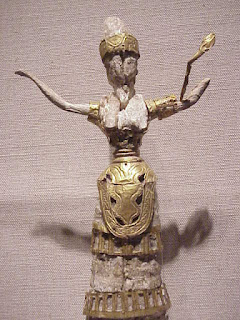
Minoan snake goddess of ivory and gold dating from 1750 to 1580 that I photographed at the Walters Art Museum in Baltimore, Maryland.
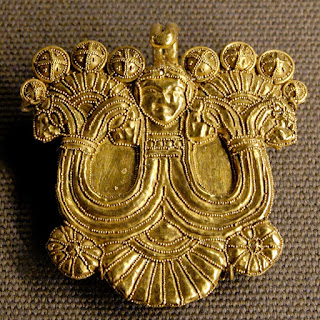
Gold pin with a Mistress of the Animals (potnia theron). Gold with granulation, Greek, ca. 630 BCE at The Louvre, courtesy of Wikimedia Commons contributor Marie-Lan Nguyen.
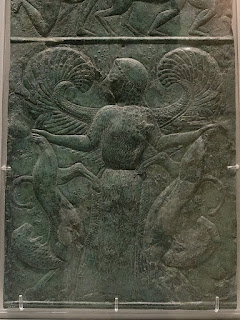
Bronze sheet with embossed representation of the Mistress of animals, probably a decorative cover of an object from a Samian workshop, about 600 BCE recovered from the Sanctuary of Olympia at the National Archaeological Museum of Athens courtesy of Wikimedia Commons contributor Zde.
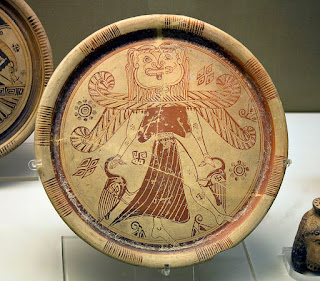
Winged goddess with a Gorgon’s head wearing a split skirt and holding a bird in each hand, a type of the Potnia Theron. Probably made on Rhodes. From Kameiros, Rhodes at the British Museum courtesy of Wikimedia Commons contributor Ealdgyth.
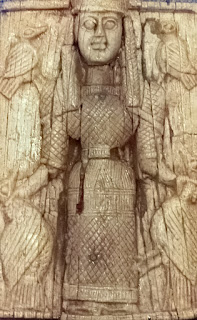
Ivory representation of the goddess Artemis Orthia found in her sanctuary, now in the National Archaeological Museum in Athens courtesy of Wikimedia Commons contributor Marsyas (white balance adjusted).
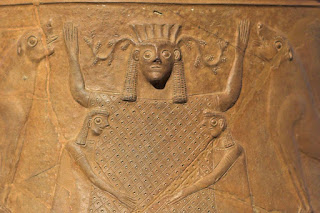
Mistress of animals (Potnia theron) and nature on a Pithos with relief, from the years 625-600 BCE. National Archaeological Museum of Athens, courtesy of Wikimedia Commons contributor Zde.
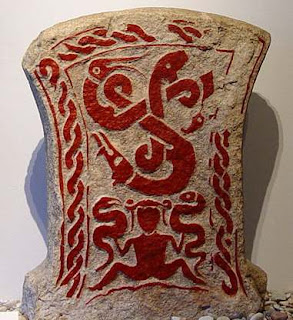
Snake-witch (Ormhäxan) stone from Gotland, Sweden. Now in Fornsalen Museum courtesy of Wikimedia Commons contributor Jürgen Howaldt.
-
글쓴이글
- 답변은 로그인 후 가능합니다.